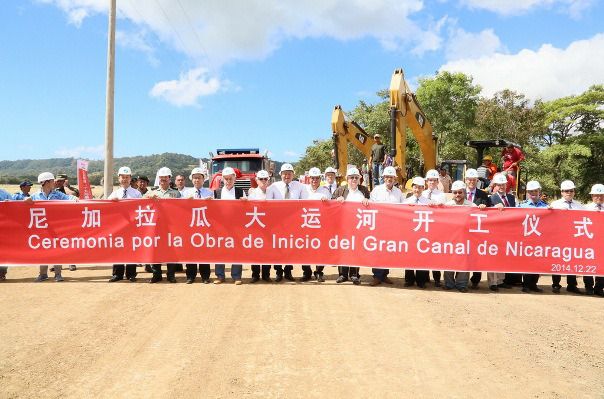A new twist in the saga of the canal?
The saga of the Grand Nicaragua Canal took another twist last week when HKND announced that it was going to suspend construction of the canal until late 2016.
The announcement came in the wake of news that the fortune of Wang Jing – the billionaire impresario behind the canal project – had plummeted as a result of the Chinese stock market crisis. A staggering 85 percent of Wang’s fortune has apparently been wiped out. The Guardian newspaper reported that his net worth had fallen from $10.2 billion to $1.1 billion.
The news clearly undermines the already precarious financial credibility of the project and adds to doubts that the canal will actually ever be built.
Ironically less than a week earlier, the Nicaraguan government formally approved a series of environmental and social impact studies conducted by British environmental consultants ERM.

ERM had been granted a three month extension to undertake further environmental studies, following a steady stream of criticism of the company’s initial report as well as wider concern about the likely environmental impact of the canal. Government approval of the ERM studies was accompanied by formal permission for HKND to begin what canal commission President Manuel Coronel called the ‘structural design and construction processes’.
The decision to delay construction follows the revelation that McKinsey & Company, the financial advisors who had been engaged by the Ortega government and HKND to conduct a financial viability study, had done no work HKND since 2014. Their report – assuming that one exists – has never been made public.
For critics of the canal, this stands as yet another example of the secrecy with which the Nicaraguan government has shrouded the canal project. As an article on JOC.com put it, the news that McKinsey was no longer working for HKND ‘rais[es] new questions about the Nicaraguan government’s public statements’.
What next for the canal? Scenarios for HKND
It is difficult to gauge where the canal is going. Recent news is hardly reassuring.
As a report in Confidencial noted, the collapse of Wang’s own fortune calls into question his ability to manage the finances of other companies, let alone a $40 billion plus project like the canal.
The report notes that the dramatic decrease in Wang’s fortunes could see Wang sell his concession to another, more solvent, entrepreneur. However, given the doubts about the canal’s viability, its economic benefits, and its environmental impact, it is difficult to imagine another businessmen or private company taking the project on. Such a scenario would also undoubtedly be personally deeply embarrassing for both Wang and for President Daniel Ortega.

It seems far more likely that Wang and HKND will remain involved but would be obliged to work under a new, more rigorous and complex financial structure. Given Wang’s new-found financial vulnerability and what Confidencial describes as ‘the threat to the sustainability of the canal as a result of potential insolvency, bankruptcy or inability to pay loans’, Wang would surely be required to conduct his business in a way that is far more open and transparent than has been the case up to now.
According to Confidencial, the canal project will also likely require some, perhaps many, new investors. HKND might eventually be able to contribute 5-10% only of the funds required to complete the canal. The remaining 90-95% would have to come from alternative investors. Under such arrangements, it is difficult to see how the 100 year concession (an initial 50 years, with the option to renew for a further 50) would be tenable, and HKND might have to be ‘coaxed eventually to abandon the concession to minimise or contain losses if the business goes bad’. For their part, investors would surely demand much shorter repayment terms and higher interest rates.
What next for the canal? Scenarios for the government
Wang’s problems also have serious implications for the Nicaraguan government.
The Ortega government would also be required to underwrite financial guarantees to investors in the project. Quite how a country which is the second poorest in the Western Hemisphere would go about providing credible assurance for a $40 billion project is unclear. As Confidencial observes, it is difficult to see how in ‘the following decades’, the Nicaraguan state, ‘will have the capacity of using sovereign debt to finance a grave crisis of payment’.
Confidencial argues that having given guarantees and having taken on ‘important risks’ in the past, it is incumbent on the government to now seek to minimize risks to the nation and to ensure that the private sector assumes some of the risks.
Will it happen?
Understandably, the Nicaraguan government has made no comment about Wang’s financial problems, but Ortega must be concerned. He has invested considerable political capital in the project happening, and has staked his reputation on it.
Stories in the press continue to suggest that work on the canal is ongoing. December, for example, brought with it the news that that HKND had engaged BMT group (and specifically its subsidiaries BMT Asia Pacific and BMT ARGOSS) to conduct marine safety and shipping traffic studies. But commissioning further studies is not the same as breaking ground and pouring concrete.
It is becoming increasingly difficult to see HKND and the Ortega government realizing the long standing Nicaraguan dream of a canal through the country. There is very little evidence of any actual construction taking place.
The latest LAB special report The Nicaragua Grand Canal: Economic Miracle or Folie de Grandeur? by Russell White is out now and is available from http://developmentbookshop.com/the-nicaragua-grand-canal-20091

